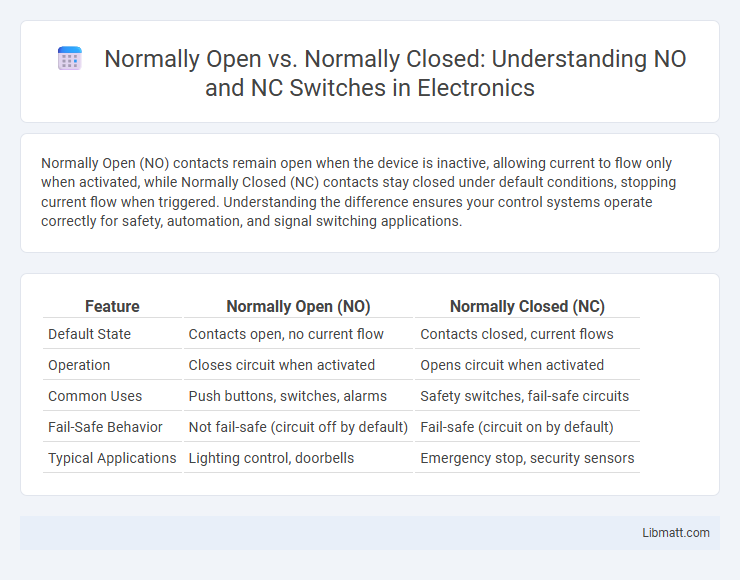Normally Open (NO) contacts remain open when the device is inactive, allowing current to flow only when activated, while Normally Closed (NC) contacts stay closed under default conditions, stopping current flow when triggered. Understanding the difference ensures your control systems operate correctly for safety, automation, and signal switching applications.
Table of Comparison
| Feature | Normally Open (NO) | Normally Closed (NC) |
|---|---|---|
| Default State | Contacts open, no current flow | Contacts closed, current flows |
| Operation | Closes circuit when activated | Opens circuit when activated |
| Common Uses | Push buttons, switches, alarms | Safety switches, fail-safe circuits |
| Fail-Safe Behavior | Not fail-safe (circuit off by default) | Fail-safe (circuit on by default) |
| Typical Applications | Lighting control, doorbells | Emergency stop, security sensors |
Introduction to Normally Open and Normally Closed
Normally Open (NO) and Normally Closed (NC) refer to the default states of electrical contacts in switches and relays. A Normally Open contact remains open when in its default, unactuated state, preventing current flow until activated. Conversely, a Normally Closed contact remains closed in its default state, allowing current flow until it is actuated to open.
Understanding Electrical Switch Configurations
Normally open (NO) and normally closed (NC) are fundamental electrical switch configurations indicating their default state when unactuated. A normally open switch remains disconnected, allowing current flow only when activated, while a normally closed switch maintains a closed circuit, interrupting current only when triggered. Understanding these configurations helps you design and troubleshoot electrical circuits by selecting the appropriate switch type for controlling power flow and ensuring safety.
How Normally Open (NO) Contacts Work
Normally Open (NO) contacts remain in an open state, preventing electrical current from flowing until an external force or signal activates them, closing the circuit. When You press a switch or trigger a sensor, the NO contact closes, allowing current to pass through and power the connected device. This behavior is essential for applications requiring circuit activation only upon specific user actions or system conditions.
How Normally Closed (NC) Contacts Operate
Normally Closed (NC) contacts maintain a closed circuit when in their default state, allowing current to flow without interruption. When an external force or signal activates the switch, the contacts open, breaking the circuit and stopping the current. Your system relies on NC contacts to ensure safety or continuous operation by default, only deactivating under specific conditions.
Key Differences Between NO and NC Contacts
Normally Open (NO) contacts remain open until activated, allowing current to flow only when the switch is engaged, while Normally Closed (NC) contacts stay closed and interrupt the current when triggered. NO contacts are commonly used for start functions and safety devices where the default state is off, whereas NC contacts are preferred in fail-safe applications where power interruption signals an alert or shutdown. Understanding these key differences in contact behavior ensures your control systems perform reliably in specific operational contexts.
Applications for Normally Open Switches
Normally open switches are widely used in safety and security systems where a circuit is intended to remain off until triggered, such as in alarm systems, emergency stop buttons, and door sensors. These switches are essential for applications requiring default power disconnection to prevent accidental activation or hazards. Common industries implementing normally open switches include industrial automation, consumer electronics, and building management systems.
Common Uses for Normally Closed Switches
Normally closed switches are widely used in safety and security systems to ensure continuous circuit operation under normal conditions, enabling immediate alerts when the circuit opens. They are common in emergency stop buttons, fire alarm systems, and fail-safe circuits where a break in the connection signals a fault or hazard. Industrial machinery and process controls utilize normally closed switches to maintain default active states and trigger actions when safety thresholds are breached.
Pros and Cons of NO vs NC Configurations
Normally Open (NO) configurations ensure circuit continuity only when activated, reducing power consumption during idle states but risking failure to actuate in critical moments. Normally Closed (NC) setups maintain circuit continuity by default, providing fail-safe operation and immediate detection of faults or disconnections, but consume power continuously and may lead to wear from constant current flow. Selecting NO or NC depends on application needs for safety, power efficiency, and fault tolerance.
Selecting the Right Contact Type for Your Project
Choosing between Normally Open (NO) and Normally Closed (NC) contacts depends on your project's safety requirements and control logic. Normally Open contacts allow current flow only when activated, making them ideal for applications where devices should remain off until triggered. Normally Closed contacts maintain circuit continuity until interrupted, ensuring fail-safe operation in emergency or safety systems.
Conclusion: Choosing Between Normally Open and Normally Closed
Choosing between Normally Open (NO) and Normally Closed (NC) depends on your specific application requirements, such as safety, default state, and desired response upon activation. NO switches remain open until actuated, making them suitable for scenarios where the circuit should stay off by default. NC switches stay closed until triggered, ideal for fail-safe conditions where the circuit must remain active unless interrupted.
Normally Open vs Normally Closed Infographic

 libmatt.com
libmatt.com